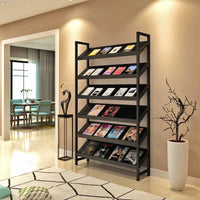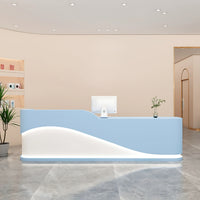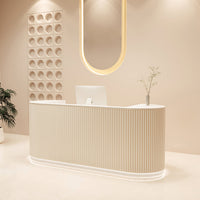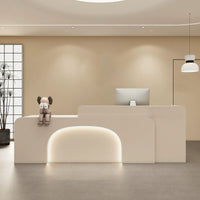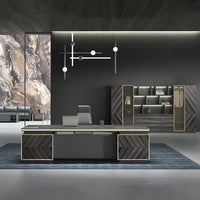How to Create a Facade for Reception Desk?
kaguyasuContent Menu
● Introduction
● Understanding the Role of a Reception Desk Facade
>> Importance of the Reception Desk Facade
>> Functions of the Facade
● Planning Your Reception Desk Facade
>> Assessing Space and Workflow
>> Setting a Budget
>> Choosing a Design Style
● Selecting Materials for the Facade
>> Common Material Options
>> Material Selection Tips
● Designing the Facade
>> Structural Considerations
>> Shape and Configuration
>> Ergonomics and Accessibility
● Building the Facade: Step-by-Step Guide
>> Gathering Tools and Materials
>> Constructing the Framework
>> Attaching the Panels
>> Adding Decorative Elements
>> Finishing the Facade
● Aesthetic Enhancements
>> Painting and Staining
>> Lighting
>> Signage and Branding
>> Personalized Touches
● Installation and Final Adjustments
>> Positioning the Facade
>> Final Inspection
>> Maintenance Tips
● Case Studies and Inspiration
>> Modern Laminate Facade
>> Classic Wood and Stone Facade
>> Budget-Friendly DIY Facade
● Frequently Asked Questions
● Citations:
Introduction
A reception desk is the first point of contact for visitors and clients, making it a critical element in shaping the perception of any business or organization. The facade of the reception desk not only serves a functional purpose by concealing the workspace and providing privacy but also plays a significant role in establishing the visual identity of the brand. This article offers a comprehensive guide on how to create a facade for a reception desk, covering everything from planning and material selection to aesthetic enhancements and installation. Whether you are a business owner, an interior designer, or a DIY enthusiast, this guide will help you design and build a reception desk facade that is both practical and visually impressive.

Understanding the Role of a Reception Desk Facade
Importance of the Reception Desk Facade
The facade is the visible front of the reception desk, acting as a visual anchor in the reception area. It sets the tone for the space, communicates professionalism, and can reflect the brand's personality. A well-designed facade can make a strong first impression, enhance the visitor experience, and even improve the functionality of the workspace behind it.
Functions of the Facade
- Conceals clutter and equipment from visitors
- Provides privacy for reception staff
- Offers an opportunity for branding and signage
- Defines the flow and boundaries of the reception area
Planning Your Reception Desk Facade
Assessing Space and Workflow
Before beginning the design process, carefully measure the reception area. Consider the following:
- Available floor space and ceiling height
- Placement of electrical outlets and network connections
- Accessibility for both staff and visitors, including those with disabilities
- Sightlines from the entrance and waiting areas
A clear understanding of the space ensures that the facade will be appropriately sized and positioned for maximum impact and usability.
Setting a Budget
Determine your budget early in the process. Factor in costs for:
- Core materials (wood, laminate, metal, stone, etc.)
- Decorative elements (trims, lighting, signage)
- Tools and hardware
- Labor (if hiring professionals) or time investment (for DIY)
- Unexpected expenses
A well-planned budget helps avoid overspending and allows for better material and design choices.
Choosing a Design Style
Consider the overall aesthetic of your office or business. The facade should complement or enhance the existing decor. Popular styles include:
- Modern: Clean lines, minimalistic, often using glass, metal, or high-gloss laminate
- Traditional: Warm woods, classic moldings, and ornamental details
- Industrial: Exposed metals, raw finishes, and bold geometric shapes
- Eclectic: A mix of materials, colors, and textures for a unique look
The chosen style should align with your brand identity and the atmosphere you wish to create.
Selecting Materials for the Facade
Common Material Options
The choice of materials affects both the appearance and durability of the reception desk facade. Consider the following options:
| Material | Pros | Cons | Best For |
|---|---|---|---|
| Laminate | Durable, easy to clean, affordable | May lack luxury feel | High-traffic areas |
| Solid Wood | Luxurious, timeless, strong | Expensive, requires maintenance | Executive offices |
| Veneer | Affordable wood look, versatile | Less durable than solid wood | Budget-conscious spaces |
| Metal | Modern, industrial, durable | Can feel cold, may scratch | Contemporary designs |
| Stone/Quartz | Luxurious, durable, unique patterns | Heavy, expensive | Hospitality, upscale |
| Glass | Sleek, modern, easy to clean | Prone to fingerprints, can chip | Minimalist designs |
Material Selection Tips
- Match the material to the intended use and expected wear.
- Consider maintenance requirements and cleaning ease.
- Mix materials for added visual interest, such as a wood base with a stone or glass accent.
Designing the Facade
Structural Considerations
The facade must be sturdy enough to withstand daily use and potential impacts. Key structural elements include:
- Framework: Typically constructed from wood or metal for strength.
- Panels: The main visible surface, which can be flat or curved.
- Supports: Brackets or internal frames to ensure stability.
Shape and Configuration
The shape of the facade can influence both aesthetics and function. Common configurations include:
- Straight/Rectangular: Classic and efficient, suitable for most spaces.
- L-Shaped: Offers more workspace and privacy, fits corner locations.
- U-Shaped: Maximizes workspace, ideal for larger reception areas.
- Curved: Creates a welcoming, modern look with smooth lines.
Ergonomics and Accessibility
Ensure the facade design allows for:
- Comfortable working height for staff
- Adequate legroom and storage behind the facade
- ADA compliance, including lower counter sections for wheelchair users
Building the Facade: Step-by-Step Guide
Gathering Tools and Materials
Essential tools may include:
- Measuring tape and level
- Saw (hand, circular, or table saw)
- Drill and screwdriver
- Clamps
- Sandpaper or electric sander
- Paintbrushes or rollers
- Safety gear (gloves, goggles, dust mask)
Constructing the Framework
1. Cut the frame pieces (usually from 2x4 lumber or metal studs) to size.
2. Assemble the frame using screws or brackets for stability.
3. Attach the frame securely to the floor or existing desk base.
Attaching the Panels
1. Cut facade panels (plywood, MDF, laminate, etc.) to fit the frame.
2. Attach panels to the frame using screws, nails, or adhesive.
3. Ensure all edges are flush and corners are square.
Adding Decorative Elements
- Apply trims or moldings to conceal seams and add detail.
- Install accent materials (stone, metal strips, glass inserts) as desired.
- Sand all surfaces smooth before finishing.
Finishing the Facade
- Paint or stain the facade according to your design plan.
- Apply protective coatings for durability.
- Allow finishes to dry completely before use.
Aesthetic Enhancements
Painting and Staining
Choose colors that reflect your brand or desired atmosphere. High-gloss paints offer a modern look, while stains highlight natural wood grain for a classic feel. Always sand surfaces before applying paint or stain for a smooth, lasting finish.
Lighting
Integrate LED strips, spotlights, or backlighting to highlight the facade and create a welcoming ambiance. Lighting can also be used to accentuate signage or decorative features.
Signage and Branding
Add your company logo, nameplate, or other branding elements to the facade. These can be made from acrylic, metal, or vinyl and should be positioned for maximum visibility.
Personalized Touches
Incorporate unique features such as custom hardware, decorative panels, or even digital displays to make the facade stand out and reflect your business's personality.
Installation and Final Adjustments
Positioning the Facade
Carefully move the completed facade into place, ensuring it aligns with the existing desk structure and the room layout. Secure it to the floor or wall if necessary for stability.
Final Inspection
- Check for stability and level surfaces.
- Ensure all finishes are smooth and free of defects.
- Confirm that all functional elements (storage, cable management, accessibility features) are in place and usable.
Maintenance Tips
- Clean surfaces regularly with appropriate cleaners.
- Inspect for wear or damage and repair promptly.
- Refinish or repaint as needed to maintain appearance.
Case Studies and Inspiration
Modern Laminate Facade
A technology company opted for a high-gloss white laminate facade with integrated LED lighting and a glass accent panel. The result was a sleek, futuristic look that matched their brand identity and was easy to maintain.
Classic Wood and Stone Facade
A law firm chose a solid wood facade with a marble countertop and brass trim. This design conveyed professionalism and luxury, impressing clients and providing a durable work surface.
Budget-Friendly DIY Facade
A startup built a plywood and MDF facade, painted in their brand colors, and added simple molding for detail. The project was affordable, customizable, and created a welcoming first impression.
Frequently Asked Questions
Q1: What is the best material for a reception desk facade?
A: Laminate is popular for its durability and easy maintenance, while solid wood or stone offers a luxurious look. The best material depends on your budget, style, and usage needs.
Q2: How can I make my reception desk facade more accessible?
A: Include a lower counter section for wheelchair users and ensure there is enough clearance for easy approach and use.
Q3: Can I build a reception desk facade myself?
A: Yes, with basic carpentry skills and the right tools, you can build a facade using materials like plywood, MDF, or laminate. There are many DIY plans and tutorials available online.
Q4: How do I incorporate branding into the facade?
A: Use signage, color schemes, and materials that reflect your brand identity. Add your logo or company name in a prominent location on the facade.
Q5: How do I maintain the appearance of my reception desk facade?
A: Clean regularly with suitable products for your materials, repair any damage promptly, and refinish surfaces as needed to keep the facade looking new.

Citations:
[1] https://archicfurniture.com/blogs/furniture/diy-receptionist-desk
[2] https://foter.com/cheap-reception-desk
[3] https://www.formica.com/en-gb/articles/trends/the-perfect-surface-material-for-your-reception-desk
[4] https://www.woodbrew.tv/blog/reception-desk-build
[5] https://kronosceramiche.com/project-planning/custom-reception-desk/
[6] https://www.brooklynmillwork.com/posts/6-types-of-materials-used-for-custom-reception-desks
[7] https://www.pinterest.com/dogsmostly/reception-facade/
[8] https://www.reddit.com/r/woodworking/comments/sq002m/reception_desk_i_designed_made_with_a_hard_maple/
[9] https://www.youtube.com/watch?v=yosecgWLhRE
[10] https://www.talkshopbot.com/forum/archive/index.php/t-16711.html
---
Hot Tags: China, Global, OEM, private label, manufacturers, factory, suppliers, manufacturing company



